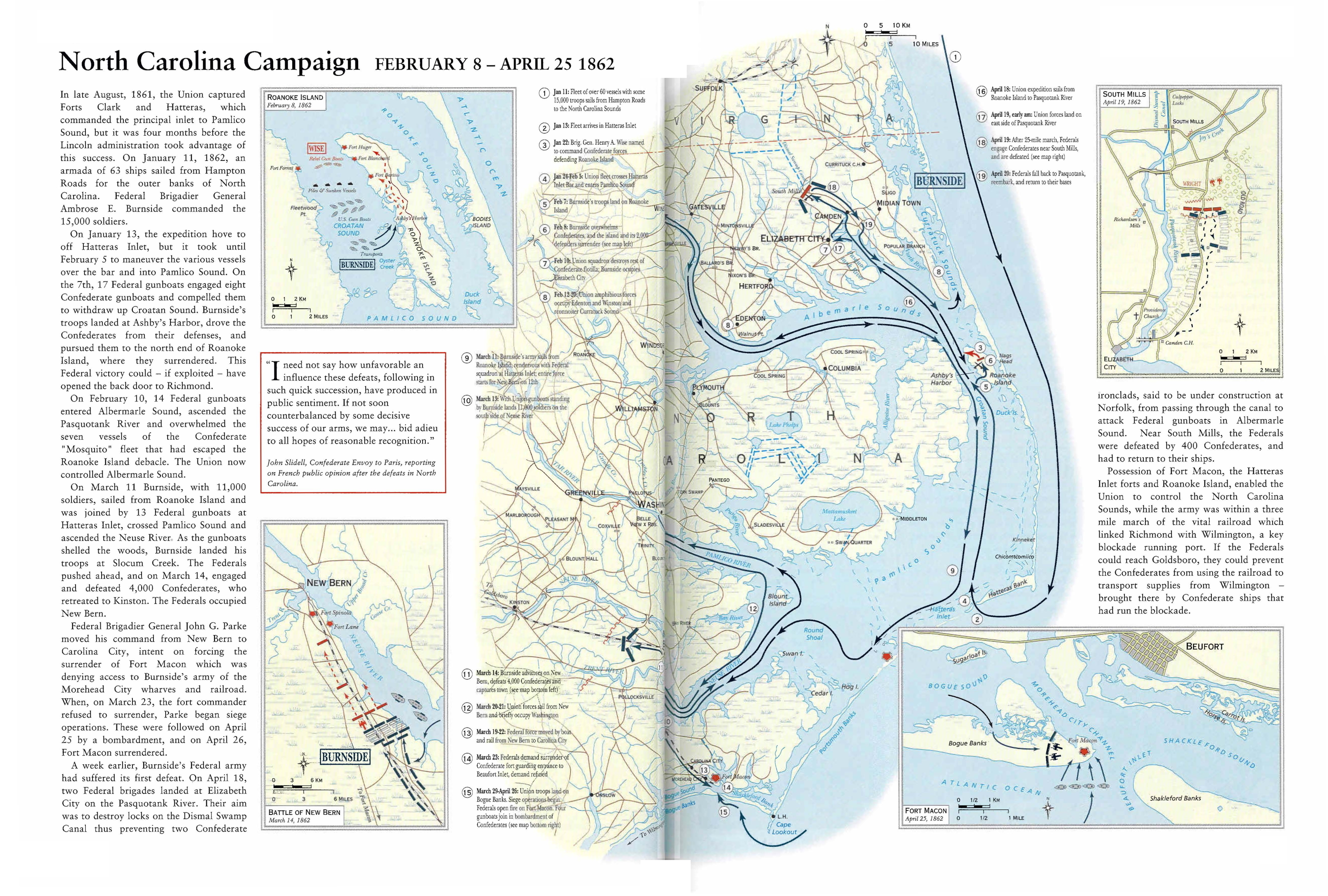
March 14, 1862
Union forces captured New Bern, North Carolina, on March 14, 1862. New Bern is located in the eastern part of the state, some 87 miles northeast of Wilmington on the Neuse River. Following the Union capture of Roanoke Island, North Carolina, in February 1862, Confederates in New Bern braced for a Union attack. Brigadier General Lawrence O’Bryan Branch had command of 4,000 largely untested troops, who occupied a defensive line about 6 miles south of New Bern on the Neuse. Fort Thompson, mounting 13 guns, anchored the left of the Confederate line on the Neuse River.
Confederate engineers believed an attack on New Bern would come by water, so 10 of the fort’s guns faced the river, while only 3 covered the land approaches. From Fort Thompson, a line of entrenchments stretched westward for about a mile to the Atlantic and North Carolina Railroad line. Because of a shortage of manpower, rather than continue these fortifications across the railroad tracks toward Brice’s Creek, Branch positioned his troops on the right of his line, 150 yards behind an arm of Brice’s Creek. This placement led to a gap of 150 yards in the Confederate line along the railroad at Wood’s Brickyard.
On March 11, 1862, Union brigadier general Ambrose Burnside began the assault on New Bern. His 11,000-man force boarded ships at Roanoke Island, then rendezvoused with U. S. Navy warships off Hatteras. The expeditionary force entered the Neuse River early in the afternoon of March 12 and anchored near the mouth of Slocum Creek that night.
At dawn the next morning, Union gunboats bombarded the North Carolina shore in preparation for the landing. The shelling was unnecessary, as there were no Confederate troops in the area. The Union soldiers landed unimpeded.
After coming ashore near Slocum Creek, Burnside’s troops began their march to New Bern, 17 miles distant, but heavy rains that day made the journey slow and difficult. Union troops made camp near the Fort Thompson line on the night of March 13.
At 7:00 a. m. on March 14, Burnside’s men advanced in three columns toward the Confederate positions. Brigadier General Jesse Reno commanded the Union troops to the left of the railroad, while Brigadier General John G. Foster’s brigade advanced on the right between the railroad and the Neuse River. Brigadier General John Parke’s brigade was held in reserve along the railroad, positioned to support either Reno or Foster.
Foster’s command made first contact with the Confederates, immediately encountering devastating Confederate musket and artillery fire, including the three land-sited guns at Fort Thompson. A number of shells from the Union gunboats, firing in support of the attack, also landed within the Union lines, although Foster was able to get word to the gunboats and have them cease fire. He brought up his two reserve regiments to continue the attack on the Confederate position but was unable to break the Confederate line.
On the Union left, Reno discovered the 150-yard gap in the Confederate line and prepared to attack it. The only Confederate troops guarding this break in Branch’s line were local militiamen who had been in service for only two weeks and were armed with only shotguns or hunting rifles. Reno personally led the charge of his men across the railroad against the militia, which soon fled in panic. But as Reno attempted to bring up more men to exploit the breach in the Confederate line, Branch sent reinforcements to seal it. Following heated action, Reno was forced to pull back, and the Confederate line stabilized.
Shortly after 11:00 a. m., Parke ordered his men forward against the Confederate center. Breaching the line, Parke’s men turned right and struck the Confederate troops occupying the breastworks between the railroad and Fort Thompson. Seeing the enemy behind their breastworks, the Confederate soldiers gave way. Branch then ordered a general retirement. The Confederates fled across the Trent River Bridge, which was destroyed after the last of them had crossed it. Later that afternoon, Burnside’s men crossed the river and occupied New Bern.
The capture of New Bern cost the Union 440 casualties. Confederate losses were 578. Fearful that Burnside’s army would sweep across North Carolina and divide the upper Confederacy, Confederate officials dispatched additional troops to the area.